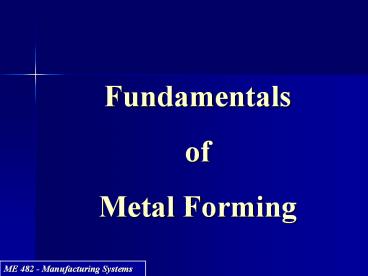Fundamentals PowerPoint PPT Presentation
Title: Fundamentals
1
Fundamentals of Metal Forming
2
Fundamentals of Metal Forming Bulk deformation vs
Sheetmetal working Bulk deformation Low
surface area to volume ratios Operations
increase surface area to volume ratios
Operations are rolling extrusion forging
drawing
3
- Fundamentals of Metal Forming Bulk
deformation - Rolling characteristics
- compressive deformation 2 or more rolls
strong frictional relationship - Extrusion characteristics
- compressive deformation force metal
through die opening strong frictional
relationship hot and cold working process
4
Fundamentals of Metal Forming Sheet
metalworking Characterized by large surface
area to volume ratios little ratio change
after process machines called presses parts
called stampings tools are punch and die
Operations bending drawing shearing
5
- Material Behavior Flow Stress
- K en
- Concept of flow stress, Yf the instantaneous
stress required to deform the material - Yf K en
- Process force considerations
- during compression, determine instantaneous
force from Yf max force is often all that is
required, typically at end of stroke force
analysis may be based on average stresses and
strains - Average flow stress Yf K en /(1 n)
6
Fundamentals of Metal Forming Temperature and
Metal Forming K and n depend on working
temperature, characterized by 3 ranges
Cold working Warm working Hot
working
7
Fundamentals of Metal Forming Temperature and
Metal Forming cold working Advantages
good accuracy and tolerances better surface
finish strain hardening increases strength and
hardness directional properties energy
economy Disadvantages higher
forces/power strain hardening limits
deformation may need to anneal
8
Fundamentals of Metal Forming Temperature and
Metal Forming warm working Advantages
above room temp., but below re-crystallization
temp. (0.3 Tm) lower forces and power
reduced strain hardening more difficult
geometry no need for annealing Disadvantages
more energy limited geometry
9
Fundamentals of Metal Forming
Temperature and Metal Forming hot
working Advantages above re-crystallization
temp. (0.5 Tm lt T lt 0.75 Tm) lower forces and
power no strain hardening difficult
geometry isotropic properties Disadvantages
more energy poorer surface finish
shorter tool life
10
Fundamentals of Metal Forming -
Strain Rate Note Strain rate a strong
function of working temperature (high
values -gt 1000 s-1) where v speed of testing
head h instantaneous height of part being
worked Strain rate equation C strength
constant m strain-rate coefficient
We will mostly assume that strain rate is
negligible at room temperature!
11
Friction and lubrication Friction
undesirable retards metal flow (residual
stresses defects) increases force and power
requirements wears tooling high temperature
stiction Lubricants reduce frictional
effects remove heat and material lengthen
tool life may react chemically with tool or
work concerns about toxicity,
flammability.(mineral oils, emulsions,
oils, graphite, glass..)
Lubricants are usually oil-based, and when used
in extreme pressure situations, sulfur, chlorine
and phosphorus in the lubricant may chemically
react with the metal surfaces (tool, chip). The
reactions form a surface boundary layer that is
more effective than the lubricant itself in
reducing friction. Lubricants are most effective
at cutting speeds lt 400 ft/min.
12
Example 20.6 For a metal with K 50,000 lb/in2
and n 0.27, determine the average flow stress
that the metal experiences if it is subjected to
a stress that is equal to its strength
coefficient K.
Solution Yf K 50,000 50,000 en Thus e
1 Yf 50,000 (1) 0.27/1.27 39,370 lb/in2
13
What have you learned?

